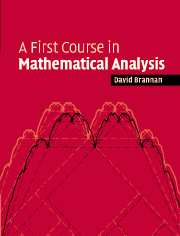Book contents
- Frontmatter
- Contents
- Preface
- 1 Numbers
- 2 Sequences
- 3 Series
- 4 Continuity
- 5 Limits and continuity
- 6 Differentiation
- 7 Integration
- 8 Power series
- Appendix 1 Sets, functions and proofs
- Appendix 2 Standard derivatives and primitives
- Appendix 3 The first 1000 decimal places of √2, e and π
- Appendix 4 Solutions to the problems
- Index
Preface
Published online by Cambridge University Press: 05 September 2012
- Frontmatter
- Contents
- Preface
- 1 Numbers
- 2 Sequences
- 3 Series
- 4 Continuity
- 5 Limits and continuity
- 6 Differentiation
- 7 Integration
- 8 Power series
- Appendix 1 Sets, functions and proofs
- Appendix 2 Standard derivatives and primitives
- Appendix 3 The first 1000 decimal places of √2, e and π
- Appendix 4 Solutions to the problems
- Index
Summary
Analysis is a central topic in Mathematics, many of whose branches use key analytic tools. Analysis also has important applications in Applied Mathematics, Physics and Engineering, where a good appreciation of the underlying ideas of Analysis is necessary for a modern graduate.
Changes in the school curriculum over the last few decades have resulted in many students finding Analysis very difficult. The author believes that Analysis nowadays has an unjustified reputation for being hard, caused by the traditional university approach of providing students with a highly polished exposition in lectures and associated textbooks that make it impossible for the average learner to grasp the core ideas. Many students end up agreeing with the German poet and philosopher Goethe who wrote that ‘Mathematicians are like Frenchmen: whatever you say to them, they translate into their own language, and forthwith it is something entirely different!’
Since 1971, the Open University in United Kingdom has taught Mathematics to students in their own homes via specially written correspondence texts, and has traditionally given Analysis a central position in its curriculum. Its philosophy is to provide clear and complete explanations of topics, and to teach these in a way that students can understand without much external help. As a result, students should be able to learn, and to enjoy learning, the key concepts of the subject in an uncluttered way.
- Type
- Chapter
- Information
- A First Course in Mathematical Analysis , pp. ix - xiiPublisher: Cambridge University PressPrint publication year: 2006

